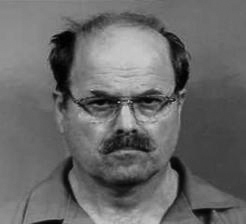Dennis Rader
The BTK Killer conformed to the classic serial killer profile, showing that any combination or social profiling will always yield an adaptation to the serial killer profile. The BTK killer was a man named Dennis Rader, outwardly a pillar of his community. But the mask of a law-abiding family man with children and ties to community leadership hid a deviant sadist whose lust for sexual release via strangulation and killing struck again and again. Childhood zoosadism and sexual handling of women’s underwear also flagged Rader as a serious deviant. But these signs were concealed.
Between 1974 and 1991, residents of Wichita, Kansas kept one eye out at all times. The BTK killer fascinated the public after his arrest because his “subterranean” lusts were so skillfully hidden beneath the appearance of normality. On that basis anyone might be a serial killer, a concept that both threatens society and challenges it. Rader acknowledged after arrest and sentencing that the victims were an ends to a means, and that he did not expect victims’ families to forgive him. The BTK killer is the record holder for waste of human life for the most trite and misguided of purposes.
The BTK killer tortured his victims and created a universe of pain he controlled. But nothing could stop his cyclic sexual urges that required sadistic episodes of induced terror in others to furnish the BTK killer with sexual pleasure. The first murders, as many serial killers experience, were experiments based on projected fantasies. He grew more crafty over time, changing his method of targeting likely episodes, victims, and environments of his prey to maximize pleasure and enjoyment without risking exposure unduly.
That one man could hold Wichita, Kansas, in fear for over thirty years is a testimony to the law enforcement gaps and social complacency of American culture. Women of that era made a habit of checking their phone cords for a dial tone, since the first Otero murders were signaled by a clipped phone wire. The Otero murders were heinous because they involved a family, two young children, and and the mother and father killed in their own home. The young girl Josephine Otero had been repeatedly resuscitated after strangling threshold has been reached so the BTK killer could maximize his pleasure and maintain a high level of erotic thrill.
The BTK killer selected victims for opportunity and convenience, acquiring a skill at concealing his identity and an expertise in isolating likely victims where the episodes of assault would not be discovered. BTK operated in a manner that concluded in a sexual episode that also happened to be a murder scene. A gratification event for Dennis Rader left a corpse or damaged human body at the very least. The Otero three children that survived did so only because they were at school during the “project”.
The childhood fantasies and high school dreams of sexual gratification became realities when BTK was an adult. Rader himself expressed surprise (after being incarcerated) that these early signs of deviancy were not caught or observed. Rader’s sentencing allocations are almost surreal in their brisk and matter-of-fact statements of killing, torturing and murdering innocent victims. Could Rader have benefited from counseling and other types of treatment? The world will never know.
BTK used positions as a compliance officer and security guard employee as he patrolled streets and boulevards looking for potential “projects”. His sizing up of a potential victim included their habits and likelihood to be alone and isolated. Masturbation and sexual release, interleaved with the binding torturing and killing of one or multiple victims was his modus operandi. The aftermath crime scenes of BTK sickened police officers and detectives for the manner of death they suggested.
Victims were not sexually assaulted themselves, but this was threatened to gain control of the victims. The BTK killer was enacting his fantasy, and attendant sexual release was the goal. But the heightening of the sexual experience came not from intercourse but from the repeated strangulation and “control” over the life or death of the victim.Thus, any person, old or young, man or woman could be the next victim.
With practice Rader collected items in a bag he called a “hit kit” with the supplies he needed to subdue and torture his victims. Things like tape, cleaning supplies, rope, handcuffs, pantyhose, or anything the killer might need to bind and torture his victims was assembled there. Certain murders changed in their methodology slightly because BTK forgot to bring the right supplies.
Men, women and children comprised the BTK killer’s victims. His long killing spree displays the strategy of serial killer intent on satisfying his need to kill with the social requirement of avoiding capture or arrest. The BTK’s ability to remain at large benefited from rural law enforcement, disturbed crime scenes, and overall shock and what the murders suggested. Even hardened law enforcement types were appalled and sickened by the themes and evidence, crime scene photos and concepts of the case.
Unlike other serials killers like Ted Bundy or The I-5 killer, The BTK killer had a life to lose. His marriage, children and job were on the line with every kill. His need to keep that life intact competed with his need to slake his desires in a confined atmosphere of controlled killing. His program of binding, torturing, and killing competed with the need to maintain a status quo. Upon his arrest for the murders a judge granted his wife an immediate divorce.
Dennis Rader’s childhood showed signs of the same isolation and zoosadism of other killers like the Son of Sam and Ed Gein. As the oldest of four sons, Dennis had no abuse and received no religious scolding from an overbearing mother, nor was emotionally taunted by a distant father. But the background he did have taught him how accepting people could be of behavioural aberration accompanied by an authority figure. Like many opportunistic killers, Rader lived his BTK persona within roles like security guard and patroller; he was able to combine cruising for victims and other purposes.
Rader evinced no qualities of the serial killers noted elsewhere, for one very good reason. He kept these behaviors hidden and masked, his aberrations kept hidden under a complex set of accepted labels. Proud father, good husband, Boy Scout leader, church elder, community fence mender, all these disguised the opportunistic cruising and unexplained absences the BTK used to satisfy his needs.
Poems enhancing the grandeur of his exploits began to appear form the BTK killer. A phone call in his own voice announcing a homicide also showed boldness. The BTK killer confided that he had wanted to divorce his wife to free up his time for “trolling” for victims. His fantasies could take shape and if possible he might isolate or stalk the victims until a killing episode came together. The cruising for victims and stalking particular “projects” have the BTK a sense of security to control the victim when the time came.
The BTK killer evolved into a persona that notes delivered to police and authorities seeking attention for his “achievements”. The BTK killer even termed his kills as intended victims as “projects” he could mull over and plan for. Dennis Rader had a past with national service and collected a lot of hardware yet did not distinguish himself in school or with other pursuits. Unlike the “Son of Sam” Rader needed no complex system of demonic threats to galvanize his killings. Fantasies from childhood and arousal thresholds triggered by spankings or wounded animals grew into deranged killing manias.
The ability to blend in and become one of the group kept the BTK killer in a secure social network that helped him function longer than isolated social “islands” like the Son of Sam and Ed Gein. Even Ted Bundy augured for more publicity as an acknowledged serial killer, but then Bundy didn’t have as intact a real life as Dennis Rader did. So completely did Rader fit the “bill” of social normality than when women complained about him they were rebuffed. The latent period between the 1960’s and the 1980’s defined an innocence in American social culture which did not allow women to as boldly assert boundaries or recognize predatory behavior with as much zeal as is common today.
Where Ted Bundy was a showoff, Rader contained his ego. Where Gein almost flouted his eccentricity, Rader worked hard to project the image of a “square”. Without flamboyant visible tendencies to cement the suspicions of others, The BTK killer remained at large longer than most serial killers ever will. Yet his mocking letter and taunting notes were his undoing. After “verifying” form police that a floppy disk could not be traced, Rader sent one anyway. His church information and name were in the file metadata, and police closed in.
Rader had sent numerous packages and letters to enhance the BTK legend, including crime scene bits and murder victim paraphernalia that only the murderer could have produced. On of these drop-offs included a Home Depot where a surveillance camera revealed a black jeep being driven away. When the floppy disk data pinned down Rader’s identity, the black jeep in the driveway convinced police. Police then matched DNA from Rader’s daughter’s pap smear and acknowledged the near match to evidence from the crime scenes.
The BTK killer killed people for the purpose of deriving sexual pleasure from the process of strangling them, from controlling the speed and manner in which they died or clung to life. Unlike many another serial killers, The BTK killer did not want to harm or kill the actual people involved for any reason. The incidence of his sexual desire in an aberrant mode simply could not be contained and the episodes unfolded as they happened. But the setup from the vantage point of a stalker improved BTK’s chances of success. Despite more than one stalking charge BTK was not identified as the killer.
The BTK killer operated within a framework of isolated opportunities to kill other people in a limited manner, yet the cold arm’s length perspective the BTK killer had for his victims did not invalidate the value of their lives. The marathon sentence duration the BTK received ensured no parole, but as Kansas didn’t reinstate the death penalty until 1994, the BTK did not meet his own most favored end,
The BTK remains in prison in a special area, in solitary due to threatening attitudes and practices for his crimes form other inmates. Allowed mail, TV and radio, the victims of the BTK killer cry that even this is too much luxury for the deviant serial killer. Considering that boredom made him kill in later years, the isolation and sole living habits of his incarceration may be the most abusive legal punishment his psyche could stand.
Article by Roy Whyte . Visit his Google+ page for more.





[…] Dennis Rader – The BTK Killer | Serial Killers […]
are you serious he has t.v and radio? he’s sick. he should be locked in a room with nothing. Hes evil! he took the lifes of people who had family. He’d strangle people until they were near death then he would let them come back. he would put bags over his victims to blind them. I hate him. how many lives can you take away from someone?